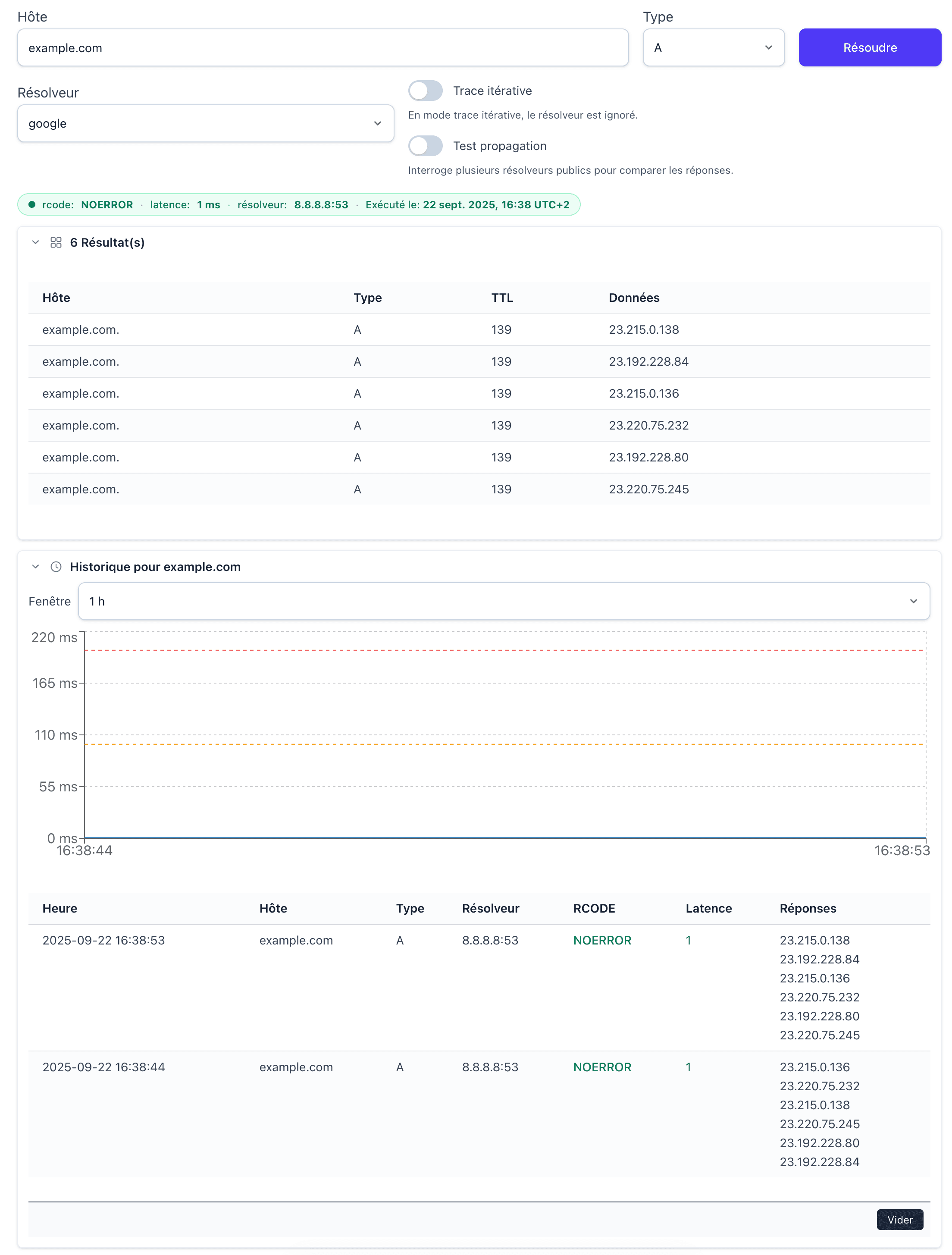What DNS lookup is used for
Diagnose the origin of a site outage.
Verify a change before a production release.
Confirm domain ownership during TXT verification.
Set up SPF DKIM DMARC BIMI and control visibility.
Prepare a migration with reduced TTL and track the real effect on the network.
Compare the response seen from your workstation with that seen from other regions.
Good to know
We often talk about DNS propagation. In reality, the system caches responses according to TTL. As long as this delay has not expired, some resolvers keep the old value. The word propagation remains practical to describe this effect.
What the tool does
Complete recursive resolution from the root to authoritative servers.
Choice of a public resolver like Google Cloudflare Quad9 OpenDNS Yandex or the authoritative server when relevant.
Display of raw responses with TTL and data.
Optional iterative trace that shows each hop and latency.
Clear reading when no structured response is found.
How DNS lookup works
Your device requests the response from the resolver configured on the workstation or router.
The resolver first consults its local cache.
Without a response, it queries a root server which indicates the top-level domain server.
The TLD server refers to the authoritative servers of the searched name.
The resolver queries an authoritative server which returns the requested record with its TTL.
The resolver caches the response to speed up future queries and returns it to your device.
Quick tip
To verify a result from your workstation, you can use nslookup on Windows and dig on Mac and Linux. These commands read the local configuration or a chosen resolver.
Understanding TTL and the famous propagation
TTL is a duration expressed in seconds. It indicates how long a response can remain in cache.
A short TTL makes a change visible faster. Very useful during a migration.
A medium or long TTL reduces the load on authoritative servers. Good for a stable service.
An ISP may keep a response longer, according to its own cache policy. It happens that the update takes longer than expected.
Practical tip
Before a switchover, reduce the TTL a bit in advance. Make the change. Control responses from multiple networks. Then raise the TTL chosen for operation.
When to launch a DNS lookup
A site no longer responds even though the server is online.
You just modified a record and want to see the actual response.
You're deploying a new service and need to validate A AAAA CNAME or MX.
You're installing SPF DKIM DMARC or BIMI and want to confirm public visibility.
You're preparing a migration and want to measure end-to-end latency and trace.
Reading a response
Presence of one or more addresses for A or AAAA
The client chooses an address from the list which distributes the load in a simple way.
Presence of a CNAME
The response shows the target. Then verify that the target indeed publishes A or AAAA.
Presence of NS and SOA
The zone is served by these hosts. The SOA serial must advance after each update.
Empty response or NXDOMAIN
No record for this name. Check spelling, subdomain and zone.
High TTL
A delay after a change is possible as long as the cache has not expired.
Limitations and points of attention
A CNAME must not coexist with A AAAA MX or TXT in the same place.
At the apex of a domain, avoid CNAME. Use an equivalent offered by the provider if present.
An MX must target a name that resolves to A or AAAA. No CNAME as MX target.
A PTR must return a name that resolves to the original address to maintain good consistency.
SVCB and HTTPS parameters guide the client but do not replace A and AAAA.
Best practices to save time
Document each change with date, TTL and reason.
Test from your network then from public resolvers.
Compare the authoritative server response with a public resolver response.
Monitor critical names and set alerts for unexpected changes.
Keep a capture of the trace when an incident occurs to share it with a provider.
Frequently asked questions
How does this differ from local commands?
The tool queries public resolvers and can display the complete trace. Local commands remain useful for quick control from your workstation.
How long to see a change?
From a few minutes to several hours depending on TTL and caches in place at ISPs and at certain public resolvers.
What to do if the response differs by region?
Wait for TTL expiration. Flush the local cache if possible. Check consistency on the authoritative servers side.
What record types to check as priority?
A AAAA CNAME MX TXT NS SOA remain the base. Depending on need, add CAA PTR SRV SVCB or HTTPS. With DNSSEC, control DS and DNSKEY.
